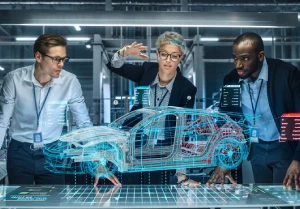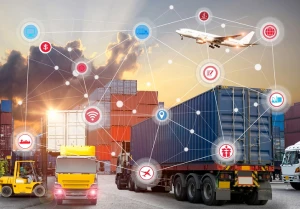The automotive industry’s digital transformation has brought about significant changes in production, customer experience, and mobility solutions. Through this process, several key lessons have emerged, helping the industry optimize operations, enhance innovation, and adapt to shifting market demands. Here are the most important lessons learned:
- Data is a Key Driver of Innovation and Efficiency
- Lesson: Data integration and analytics are at the heart of digital transformation in the automotive industry, enabling everything from predictive maintenance to customer insights and connected vehicle services.
- Challenge: Initially, many automakers struggled to leverage data due to siloed systems, poor data quality, or lack of analytical tools.
- Takeaway: Companies must establish strong data governance, integrate data across the value chain, and use advanced analytics and AI to unlock new efficiencies and innovate faster in areas like autonomous driving and customer personalization.
- Connectivity and IoT are Essential for Smart Mobility
- Lesson: The Internet of Things (IoT) and vehicle connectivity are revolutionizing how cars are built, used, and maintained. Connected vehicles provide real-time data on performance, driver behavior, and safety, which enhances the user experience and opens up new business models (e.g., mobility-as-a-service).
- Challenge: The complexity of integrating IoT into vehicles and managing the vast amount of data generated by connected systems was a significant barrier to widespread adoption.
- Takeaway: Standardizing connectivity protocols and investing in cloud-based platforms to handle IoT data efficiently enables automakers to improve vehicle performance, enhance safety features, and offer value-added services.
- AI and Automation are Transforming Manufacturing
- Lesson: Automation and AI-powered technologies such as robotics, computer vision, and predictive analytics are transforming automotive manufacturing, leading to greater efficiency, quality, and cost savings.
- Challenge: Integrating these advanced technologies into legacy manufacturing systems was initially costly and required retraining the workforce to manage and operate new technologies.
- Takeaway: By automating repetitive tasks and using AI for real-time process optimization, automakers can significantly reduce waste, enhance precision, and boost productivity. However, careful planning and workforce training are essential to maximize the benefits of automation.
- Electric Vehicles (EVs) and Sustainability Require a Digital-First Approach
- Lesson: The shift toward electric vehicles (EVs) and sustainability goals has accelerated the need for digital technologies to manage new production processes, battery supply chains, and energy management systems.
- Challenge: The initial adoption of EV technologies faced issues related to high costs, limited infrastructure, and supply chain complexities.
- Takeaway: Digital transformation helps manage these challenges by optimizing EV production processes, improving battery lifecycle management through predictive analytics, and using digital tools to plan charging infrastructure. Sustainability initiatives, such as reducing carbon emissions and waste, can be more easily tracked and managed through digital platforms.
- Cybersecurity is Critical for Connected and Autonomous Vehicles
- Lesson: As vehicles become more connected and autonomous, they become vulnerable to cybersecurity risks, making security one of the most pressing concerns in the digital transformation of the automotive industry.
- Challenge: The industry initially underestimated the complexity and scale of cybersecurity threats, particularly for connected vehicles and autonomous driving systems.
- Takeaway: Robust cybersecurity strategies must be integrated into the entire vehicle development lifecycle, from design to deployment. Continuous monitoring, encryption, and secure communication channels are essential to protect vehicle data and ensure the safety of passengers.
- Digital Twins Enhance Product Development and Testing
- Lesson: The use of digital twins—virtual replicas of physical assets—has revolutionized product development, testing, and simulation, enabling automakers to optimize design, improve performance, and reduce time-to-market.
- Challenge: Creating and maintaining accurate digital twins requires significant data collection and processing, as well as integrating different systems across the design and manufacturing stages.
- Takeaway: Digital twins allow manufacturers to simulate vehicle performance, stress-test components, and identify potential issues before production, reducing costs and speeding up innovation. They also help optimize production processes by enabling predictive maintenance of manufacturing equipment.
- Customer-Centric Innovation is Key to Differentiation
- Lesson: Digital transformation has shifted the automotive industry toward a more customer-centric model, with a focus on enhancing the user experience through connected services, personalized features, and seamless integration with digital platforms (e.g., mobile apps).
- Challenge: Traditional automakers initially struggled to adopt a customer-first approach, focusing more on product features than on user experience.
- Takeaway: Leveraging data from connected vehicles, automakers can offer personalized services such as maintenance reminders, tailored infotainment options, and software updates over the air. Understanding customer needs and using digital tools to meet those expectations enhances brand loyalty and creates new revenue streams.
- Mobility-as-a-Service (MaaS) Requires Ecosystem Collaboration
- Lesson: The rise of Mobility-as-a-Service (MaaS), where consumers access transportation services on-demand, has transformed the automotive business model, emphasizing the importance of collaboration between automakers, tech companies, and city planners.
- Challenge: Traditional manufacturers initially struggled to shift from a product-based business model (vehicle sales) to a service-oriented model (mobility services).
- Takeaway: MaaS requires integrating digital platforms that coordinate shared mobility, ride-hailing, and car-sharing services. Collaborating with technology firms and public infrastructure providers enables automakers to tap into the growing demand for flexible and sustainable transportation options.
- Supply Chain Digitalization Increases Resilience
- Lesson: Digital technologies such as blockchain, AI-driven forecasting, and digital supply chain management tools increase transparency and resilience in automotive supply chains, allowing companies to respond more effectively to disruptions.
- Challenge: The global nature of the automotive supply chain made it difficult to quickly adapt to disruptions, as seen during the COVID-19 pandemic and semiconductor shortages.
- Takeaway: Supply chain digitalization provides greater visibility into potential bottlenecks, enables real-time tracking of components, and allows companies to predict and mitigate disruptions. It also facilitates the transition to more sustainable and ethically-sourced materials.
- Agility and Flexibility are Essential for Innovation
- Lesson: Digital transformation requires automakers to adopt more agile and flexible practices, allowing them to respond quickly to market changes, consumer demands, and technological advancements.
- Challenge: Traditional manufacturing processes were rigid and slow to adapt, leading to delays in product development and missed opportunities for innovation.
- Takeaway: By adopting agile methodologies and fostering a culture of continuous innovation, automotive companies can reduce development cycles, accelerate product launches, and stay competitive in a rapidly evolving market. Flexibility is also critical in adapting to emerging technologies like autonomous driving, EVs, and connected services.
- Leadership Commitment and Cultural Change are Vital
- Lesson: Successful digital transformation in the automotive industry requires strong leadership commitment and cultural change. Transformations have stalled in companies where leadership was not fully aligned with the goals of digital initiatives.
- Challenge: Resistance to change, particularly from traditional departments focused on legacy processes, has often slowed digital transformation efforts.
- Takeaway: Leadership must champion digital transformation as a strategic priority, fostering a culture of innovation, collaboration, and continuous learning. Clear communication, change management, and involving all stakeholders in the process are key to overcoming resistance.
Summary of Key Lessons:
- Data integration and analytics are essential for unlocking efficiency and driving innovation.
- Connectivity and IoT are critical for smart, connected vehicles and enhancing the customer experience.
- AI and automation significantly improve manufacturing efficiency and reduce costs.
- EVs and sustainability require digital tools to manage new production processes and infrastructure.
- Cybersecurity must be a top priority as vehicles become more connected and autonomous.
- Digital twins enable faster, more cost-effective product development and testing.
- Customer-centric innovations enhance loyalty and create new service-based revenue streams.
- Mobility-as-a-Service (MaaS) requires collaboration across the automotive and technology ecosystems.
- Supply chain digitalization enhances resilience and transparency, enabling companies to navigate disruptions.
- Agility and flexibility are crucial for responding to technological advancements and market demands.
- Leadership and cultural change are vital for ensuring successful digital transformation.
Digital transformation in the automotive industry is reshaping the entire value chain, from production to the end-user experience. By learning from these lessons, automakers can better adapt to the evolving landscape and capitalize on the opportunities presented by new technologies.





